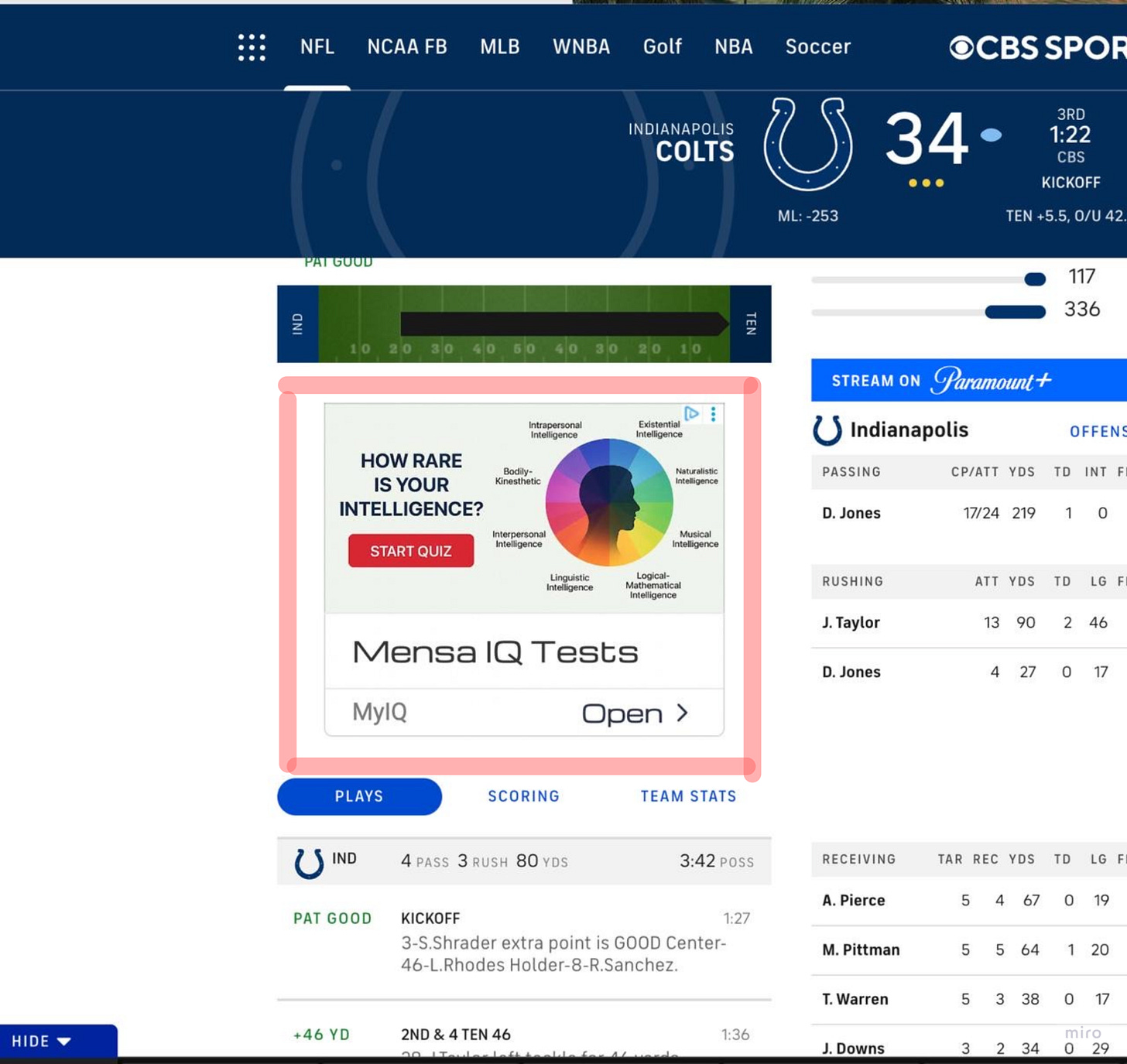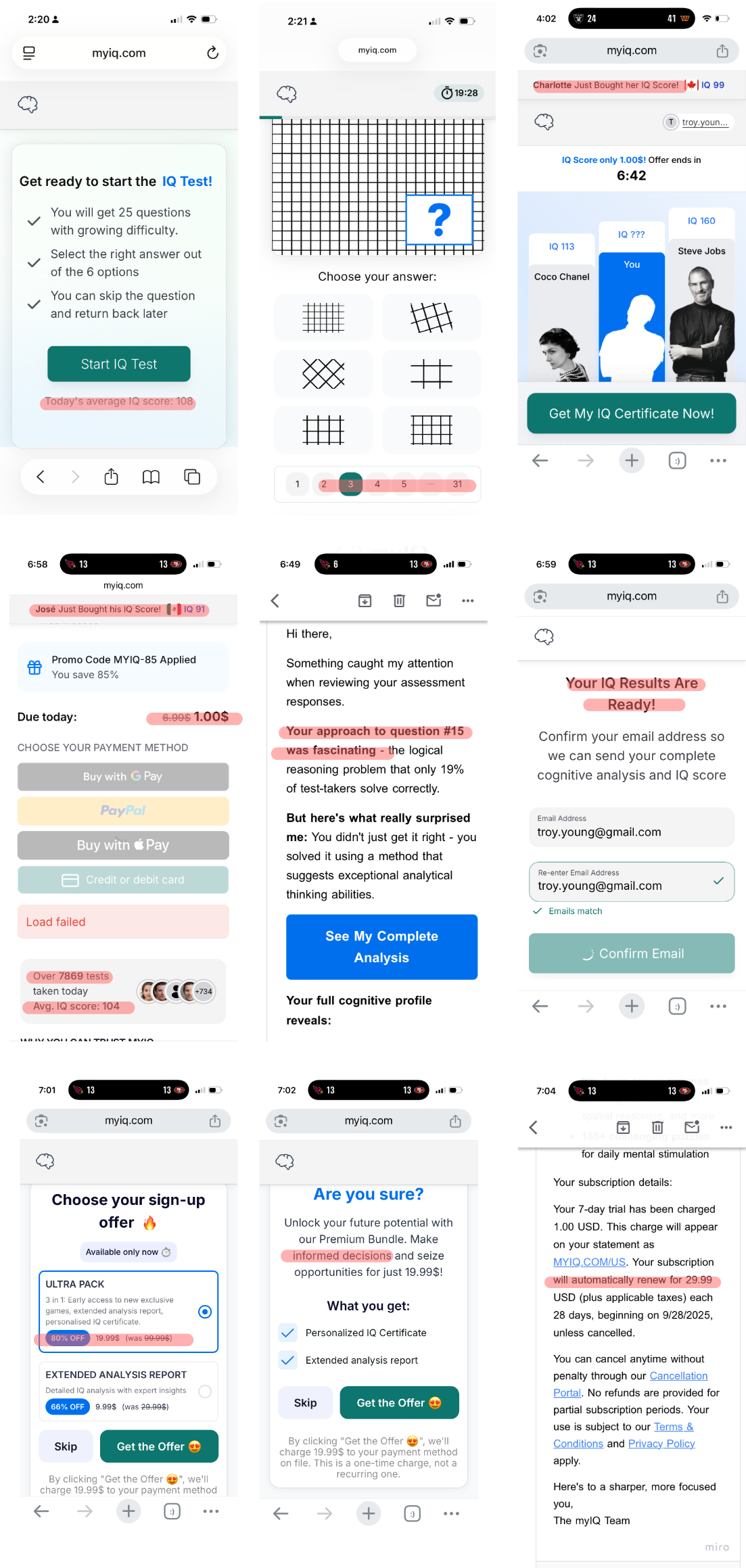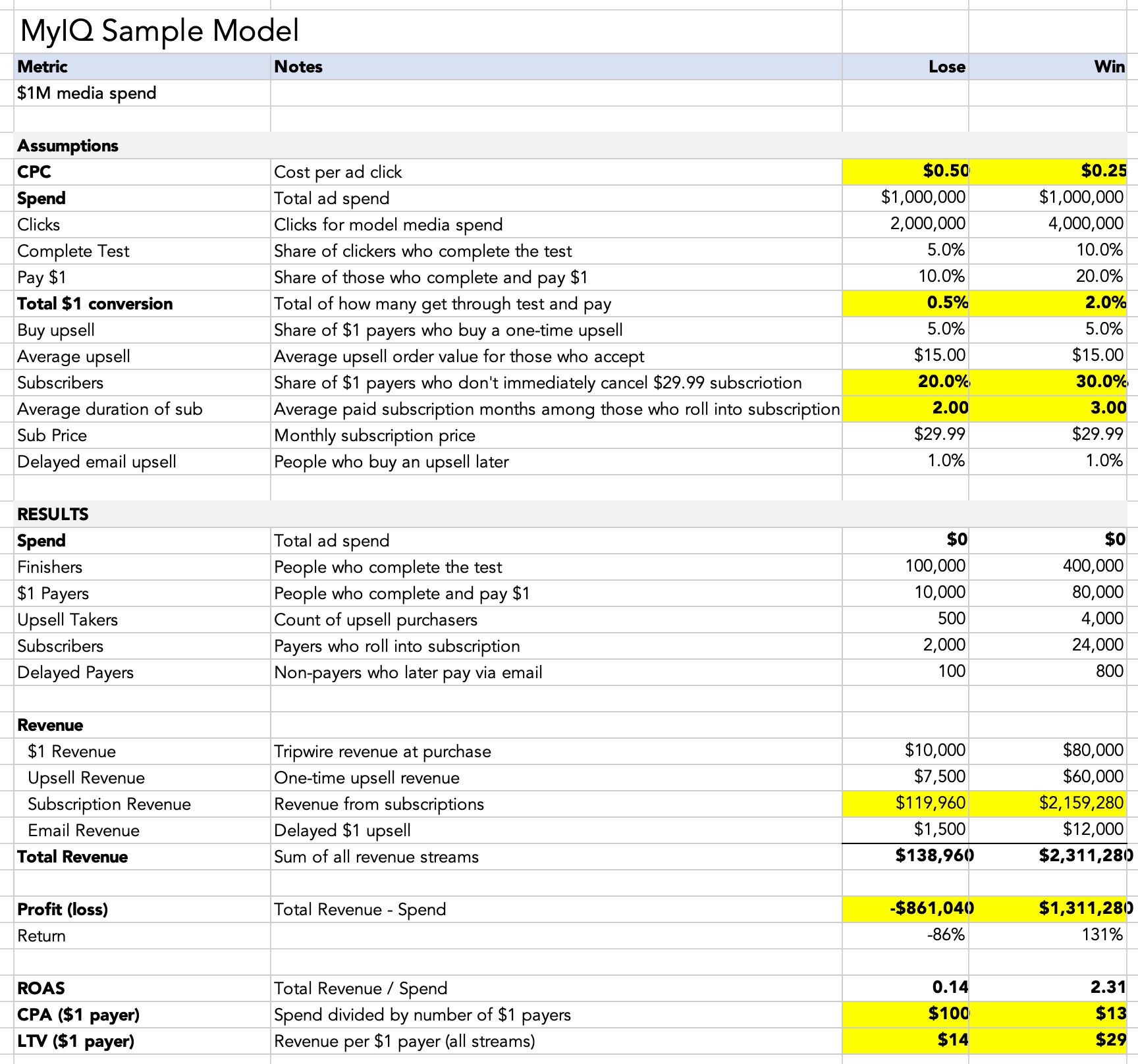What Taking an IQ Test Taught Me About Marketing
I am smarter than Coco Chanel and dumber than Steve Jobs. But nowhere near Lisa.

POD 153: A Good Racket
From gaming culture in Japan to the dark arts of online marketing, and why every good business is really a racket.
Out Friday AM. Listen.
PVA CONVERSATION
Troy: The edges of the internet are the best places to see high-order online marketing in action.
Yes, porn. Game apps. Supplements. Crypto. Sports betting. Debt relief! Online education. Tests of any sort. The dark arts are especially sublime in places where it really pays — where everything is basically margin after you clear the cost of getting a customer. One would think media people should be much better at it. But not really.
Anyhow… I was looking at investing in an online cognitive assessment business and wanted to understand how these folks get customers and make the money. These businesses are mostly just online customer acquisition machines. They are interesting to deconstruct. The truth is, anything in the online DTC (direct to consumer) game lives and dies by the simple math where the LTV (lifetime value) of the customer exceeds the CAC (customer acquisition cost) of enticing them to spend with you.
Put another way, if you don’t have a physical or third-party distribution footprint, some massively viral product that sells itself or a reliable organic promotion channel, and you want to sell stuff online and win, you absolutely have to master the art and science of performance marketing.
I wanted to see what I could learn from an IQ test.
IQ test Case Study
Now, as I like to say… “every great business is a racket” and this little case study is no different. Online IQ tests are part of the vast digital underworld. That does not mean we cannot learn from them. These businesses are characterized by:
Sophisticated mouse traps, meticulously crafted to acquire, engage and upsell customers;
Very little marginal cost outside of advertising expense;
Products whose entire focus is the alchemy of transforming free initial engagement into profitable lifetime revenue.
Because the marginal cost of delivering a customer is basically zero, they are all about the cost of acquisition and your ability to drive upsell attach rates and keep people paying, even if just for a couple of months.
As an aside, the media business has a poor history of performing the magic of trial-to-subscription. Today’s mechanic of paywall to subscription offer is a very basic and unimaginative way of playing the alchemist’s game, though the industry has matured significantly over the past few years as subs have grown in importance. Platforms are better than media brands. Substack is starting to do it pretty well.
Back to my rabbit hole. It began when a friend shared a link to an online IQ Test:
The tests themselves are marketed to feel vaguely scientific. I have no idea of any claims they make in this regard. People seem to want to be in Mensa, so that’s a nice “claim”. I do know the results are signed off by a “Dr. Sarah Chen” from the MyIQ Research Team which I have since discovered is a very popular fake online name.
Not to say that Sarah is necessarily a fake. But there are Reddit threads dedicated to the topic of the mysterious Dr. Chen. Suspicious! Beyond Sarah, the provenance of the company that runs this test is a little hard to pin down though I have been told by reliable sources that it is “some Bulgarian guy in London.” In this game, it doesn’t pay to be too visible.
What did interest me was the math underpinning the businesses. I quickly mapped out the mouse trap mechanics and ran the numbers. It seems at high levels of media investment and a deeply optimized conversion and upsell system, this thing can absolutely mint money.
Here’s roughly how you would experience it (my screenshots are further down):
You see a banner for an online IQ test. I like how they push Mensa and your “rare” intelligence. Everyone can win! Who’s not a little curious? A reliable way to engage.
A marketer could buy expensive search terms from Google to find customers or fish in the great unwashed internet at low CPCs (cost per click). You will try both, but I suspect you will make more off of turning cheap CPCs to gold with the quality of your mouse trap.Immediately engage your target in the test. Don’t ask for money. Make it light and game-like. Show average scores that you will, of course, crush. Highlight the steps. Don’t make it too long. Always include a timer.
Get personal with stuff that compares your intelligence to famous people like Steve Jobs and Coco Chanel. So smart and successful!
Now that you’ve wasted all that time, try to get the $1. It’s just a $1. It was
$6.99after all! Show how many others have bought it. José just did! You are an idiot if you don’t spend a buck.Leverage little moments to make the pitch personal. Single out items you did remarkably well on… you little smarty pants: “Your approach to question 15 was fascinating.”
Deliver the results through email. You want the results right? So give us your email… or you won’t get them.
The upsell is key. Take a bunch swings. Use colorful motivational language like: “Unlock your future potential with our Premium Bundle. Make informed decision and seize opportunities for just $19.99.” Seize opportunities you fool!
What you didn’t really appreciate is that $1 was an opt-in to a $29.99 subscription program. Why do you need a subscription to an IQ test? Because you need a bunch of shit you will never look at for $29.95. Naturally it renews monthly. This is further down the page so you will probably miss it. You can cancel if you actually realize you are now a subscriber. Some serious dark patterns here.
The entire system is predicated on paying $1 for the results. Obviously they didn’t ask in the beginning because that would stop you doing all of this.
The math is interesting:
As is always the case the the acquisition game, winning is about carefully managing tiny details of spend, offer, funnel, and retention:
Here are two scenarios. In one case you lose mightily. The other you win. For simplicity I’ve varied the following:
Cost per click falls from $0.50 to $0.25 from Lose to Win.
The test completion rate and $1 pay-up double in the Win scenario. The combined effect shift total initial conversion from 0.5% to 2.0%. Compounding!
The percentage of $1 payers who do not immediately cancel grows from 20% to 30% in Win.
The average duration of paid subscribers grows from 2 months to 3 in Win.
These are just guesses, but my numbers are not outlandish. The key is getting that subscription cancel rate down. Remember, you are subscribing for $29.99 a month even if you are not really aware. Let’s assume in the Win scenario 30% of people are fooled by this, or charitably, the IQ committed choose to subscribe to an IQ SAAS at a price richer than Netflix. Comme ci, comme ça.
If the numbers looked like what I suggested (and I think they could look much better), for every $1M dollars you spent on media, you would bring in about $2.3M in revenue, netting $1.3M in profit before cancellations and the cost of maintaining your platform. Spend $100M and now you are flying private. Cash the check while the going is good because the windfall won’t last forever.
The real magic happens when you can juice the number of people that don’t see the sub message or forget to cancel. Run those numbers up to 50% and 4 months average and you will make $4M in profit / contribution on your $1M investment. Of course, the sub price is high because most people do not know it exists and you are not in any way selling that number.
Getting cheap inventory makes everything juicy. If you can get that down in a model where all your costs are media and you have a reliable way of turning shitty low cost impressions into money you can mint. At $.10 CPC, you can net $2.9M profit on $1m investment.
Closing observations:
The friction of paying for anything online with a card means you have to get someone really engaged for free before you hit them. I guess this is the nature of the entire free/paid app economy. This is the problem with media paywalls. They are not really good at sampling to get you engaged.
Turning initial engagement into a personalized experience that teases the user with personal results is so key in moving them to the next step. Everyone wants to know why they are so unique and brilliant.
The first bit of revenue… The $1 offer is irrelevant to the end revenue. It gets your credit card. It drives commitment. It creates the opportunity to chase the big dollars in upsell, subs, and ongoing email harassment.
Swings in conversions, retention and CPM together have a massive compounding effect on CPA and LTV. Playing with low scenarios and high scenarios easily shows a 20x difference in return levels. This just highlights how critical tuning the entire system is, not just to marginal performance, but to overall business feasibility. Most people that build customer acquisition businesses have to lose money before they get the mechanics right. This is a journey.
Google, Meta, Taboola and related media sellers win big time in markets like these because the incentive is to keep spending to the point of zero marginal return. As the auction grows and competition drives prices up, they always win.
You will look down your nose at some of this, but at your peril. Sure, this group is a little unscrupulous in how they get you to subscribe. Let me remind you again that “every good business is a racket.” Let me also remind you that everybody in the subscription game slings a little fine print from time to time. Besides, Disney makes you pay to wait in line. Apple charges $29 for a $1 adapter. The NYT makes it hard to cancel. Cable companies don’t pick up the phone. Hotels charge $25 to bring coffee to your room. Hermès charges you $10k for a leather bag. If you think you can build a better IQ mouse trap produces enough money to compete on the front lines for a customer, have at it.
That’s what I learned from doing that IQ test.
Have a great weekend.









Okay, this is easily the most interesting title I've seen all week! My quiet Sunday morning brain is officially fired up and buzzing with curiosity. What a fascinating connection to make.
Honestly, it is so easy to get stuck in a marketing echo chamber, hearing the same advice over and over again. A post like this feels like a breath of completely fresh, creative air. I love the way your mind works, connecting ideas that I would never think to put in the same room.
I am so, so ready to read this and find out what the lesson was. This is the kind of unique thinking that gets me excited about my own work again. Can't wait to dive in! 🧠
i knew it lol it was easy, 'math is everything and everything is math"